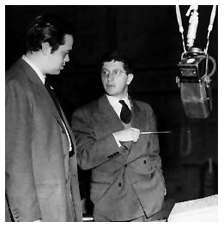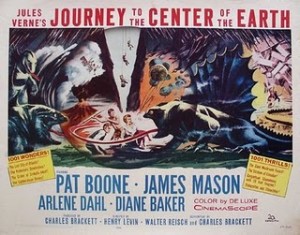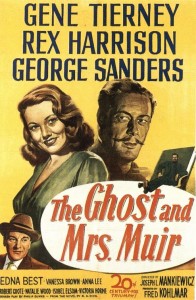Another program, “Invitation,” featured guests that included the crème de la crème of the serious music world: performers Sir Thomas Beecham, Lotte Lehmann, Oscar Levant, Mitch Miller and Wanda Landowska; and composers Samuel Barber, Darius Milhaud, Igor Stravinsky, Erich Korngold and Paul Hindemith. Even Bela Bartók dropped by when a piece of his was on the program. During a broadcast of excerpts from Handel’s Messiah commentator Ben Hyams remembered that “Beecham became so carried away that he ‘sang’ with the orchestra and chorus. CBS started getting calls on the switchboard asking if there was a madman in the studio.”
 Perhaps the most famous, at the time notorious, radio performance in history occurred during Benny’s CBS tenure. One night in 1938 he conducted the orchestra for Orson Welles’ “The War of the Worlds”, which sent many Americans—though not as many as has often been reported—through the streets in panic from a Martian invasion. Practically everyone who has heard of that broadcast associates it with Welles, but how many people know that Herrmann conducted the orchestra which provided the background music?
Perhaps the most famous, at the time notorious, radio performance in history occurred during Benny’s CBS tenure. One night in 1938 he conducted the orchestra for Orson Welles’ “The War of the Worlds”, which sent many Americans—though not as many as has often been reported—through the streets in panic from a Martian invasion. Practically everyone who has heard of that broadcast associates it with Welles, but how many people know that Herrmann conducted the orchestra which provided the background music?
 Orson Welles was the first of several men who would be associated with Herrmann—and help make him famous. Welles was given carte blanche at directing a movie at RKO Studios and, along with actors from his radio series “The Mercury Theatre of the Air”—Joseph Cotton, Agnes Moorehead, Ray Collins and Everett Sloane, among others—he took Benny to Hollywood to score a little movie called Citizen Kane.
Orson Welles was the first of several men who would be associated with Herrmann—and help make him famous. Welles was given carte blanche at directing a movie at RKO Studios and, along with actors from his radio series “The Mercury Theatre of the Air”—Joseph Cotton, Agnes Moorehead, Ray Collins and Everett Sloane, among others—he took Benny to Hollywood to score a little movie called Citizen Kane.
Citizen Kane
[audio:http://www.classicfilmfreak.com/audio/citizen kane.mp3]Thus was launched Bernard Herrmann’s long career as a composer of film scores, from 1941 with Kane until 1976 and Martin Scorsese’s Taxi Driver, the art form that would make him best known, though hardly a household word outside of movie and film music aficionados.
The rapid-fire schedule of composing for radio and the limited working time ideally suited him for the hectic creative pace of Hollywood. And as he had varied his ensemble makeup according to the ambiance of given programs, so, unlike most other Hollywood composers, he changed the orchestral makeup and timbres to reflect the settings and emotions of individual films.
 He eliminated all strings in Journey to the Center of the Earth, using instead woodwinds and brass, much percussion, many harps and five organs, including one cathedral organ. As Herrmann wrote, “I decided to evoke the mood and feeling of inner Earth, using only instruments played in low registers.” In The Day the Earth Stood Still he anticipated electronic music, with theremins and a solo violin, bass and guitar (all electronic), many timpani, a piano and harps.
He eliminated all strings in Journey to the Center of the Earth, using instead woodwinds and brass, much percussion, many harps and five organs, including one cathedral organ. As Herrmann wrote, “I decided to evoke the mood and feeling of inner Earth, using only instruments played in low registers.” In The Day the Earth Stood Still he anticipated electronic music, with theremins and a solo violin, bass and guitar (all electronic), many timpani, a piano and harps.
Journey to the Center of the Earth
[audio:http://www.classicfilmfreak.com/audio/journey3.mp3]The neglected movie The Three Worlds of Gulliver is, in author Smith’s words, “a high-spirited English lark.” That it is. Scored essentially for the traditional orchestra of strings, winds and percussion (plus piano), there are separate ensembles for the “three worlds.” England, Gulliver’s starting point in his journey, is scored for full orchestra, a comical, almost Elgarian march combined with the outer trappings of Handel himself, who would be a mainstay of English musical life a generation or so following the publication of Jonathan Swift’s Gulliver’s Travels in 1726. Lilliput, the land of little people, is delicately scored for two harps and celesta, and Brobdingnag, by contrast the land of giants, is for tuba and contrabass tuba. Herrmann produced a delightful Yorkshire pudding of English pomp and pretensions, a seemingly period pastiche of 18th-century style and forms—minuets and hornpipes. The scoring tour de force, a contest between two Lilliputian preachers, in some ways the highlight of the score, is similar to Benny’s “Duel with the Skeleton” in The Seventh Voyage of Sinbad.
The Seventh Voyage of Sinbad
[audio:http://www.classicfilmfreak.com/audio/sinbad.mp3]By contrast, in denying himself the kaleidoscopic coloring of multiple and varied instruments, Herrmann created his most famous score for another of his important collaborators, Alfred Hitchcock. Now limiting himself to strings alone—since the film was in black and white, he said, why not a “black and white sound”?—he produced in many ways his most classical score but with an unclassical bent of horror, now menacing and distraught, at other turns broodingly neurotic. The film was Psycho. The shower scene when Janet Leigh is repeatedly stabbed by Norman’s “mother” is the most famous scene in all film scoring, all forty-five seconds of it.
 A chronological sampling of his other scores displays a variety of orchestration and sounds. There is a more conventional scoring—full orchestra, 19th-century style and darkly romantic—in Jane Eyre, another link to Orson Welles, who starred as Charlotte Brontë’s morose Rochester. It’s been suggested that Welles directed part of the film. By contrast, The Ghost and Mrs. Muir (Benny’s own favorite among his film scores) is subtlely orchestrated, soft and impressionistic. Comical and irreverent, The Trouble with Harry was his first film for Hitchcock; he later arranged the music into a suite, which he called A Portrait of Hitch. Vertigo, another Hitchcock movie, is lushly romantic and ethereal, even Wagnerian to the point of Benny paraphrasing the “Liebestod” from Tristan und Isolde.
A chronological sampling of his other scores displays a variety of orchestration and sounds. There is a more conventional scoring—full orchestra, 19th-century style and darkly romantic—in Jane Eyre, another link to Orson Welles, who starred as Charlotte Brontë’s morose Rochester. It’s been suggested that Welles directed part of the film. By contrast, The Ghost and Mrs. Muir (Benny’s own favorite among his film scores) is subtlely orchestrated, soft and impressionistic. Comical and irreverent, The Trouble with Harry was his first film for Hitchcock; he later arranged the music into a suite, which he called A Portrait of Hitch. Vertigo, another Hitchcock movie, is lushly romantic and ethereal, even Wagnerian to the point of Benny paraphrasing the “Liebestod” from Tristan und Isolde.
The Ghost and Mrs. Muir
[audio:http://www.classicfilmfreak.com/audio/mrs muir.mp3]
The Trouble with Harry
[audio:http://www.classicfilmfreak.com/audio/trouble with harry.mp3]
Thought the Theramin Paced Dali in the 1948 “Spellbound”?